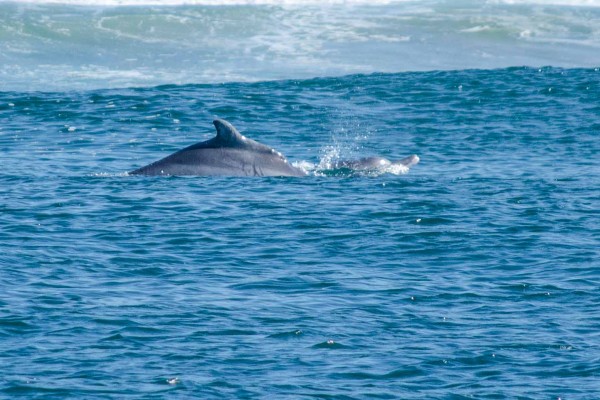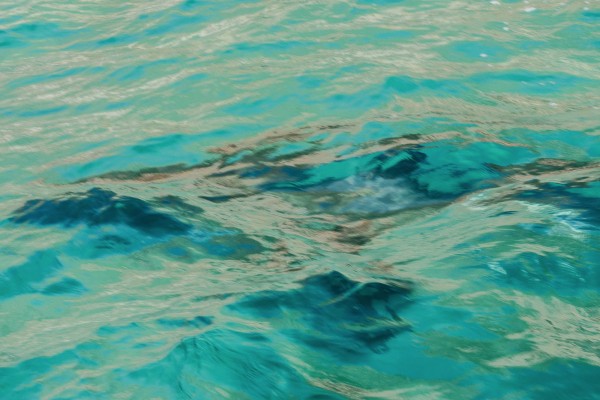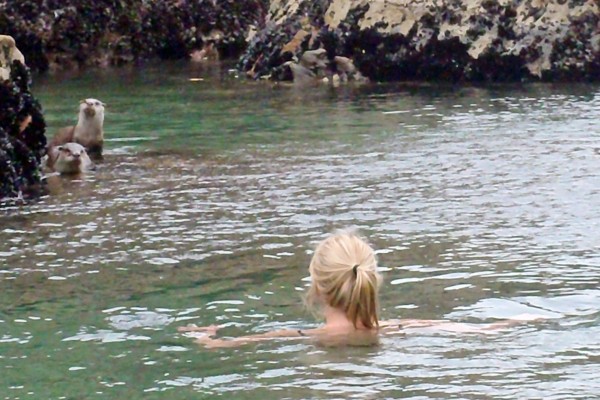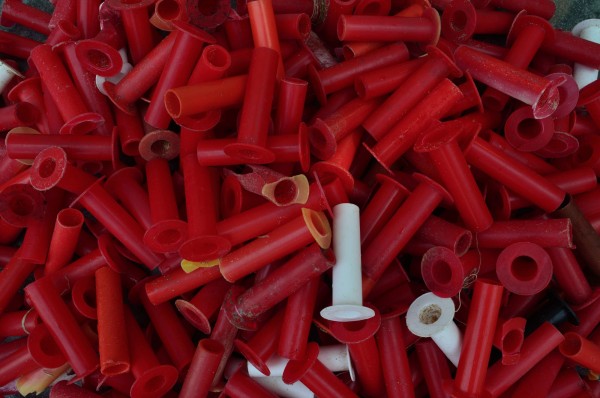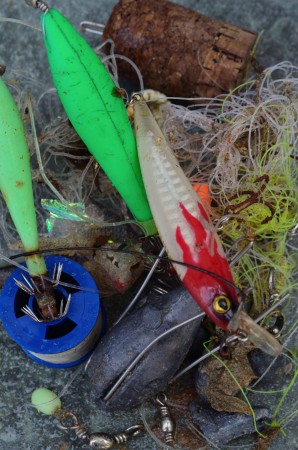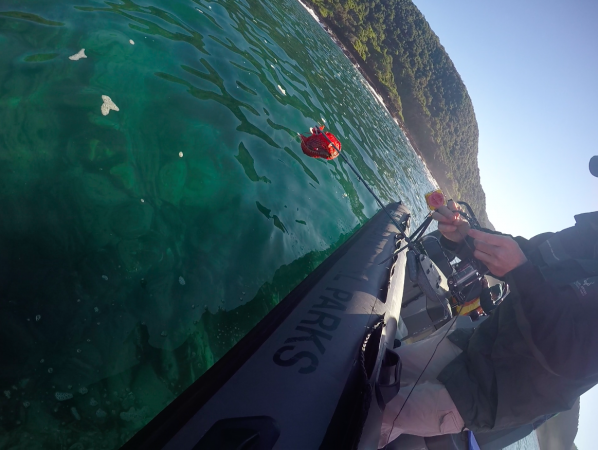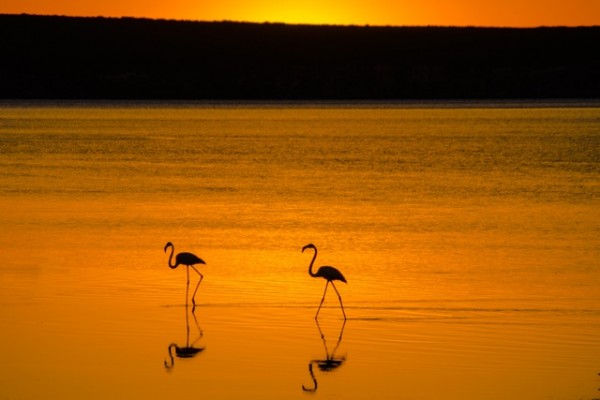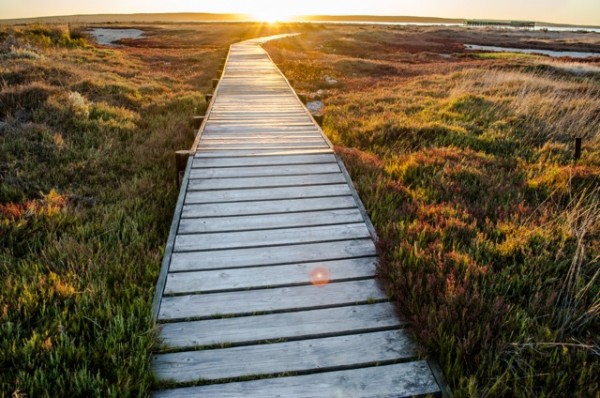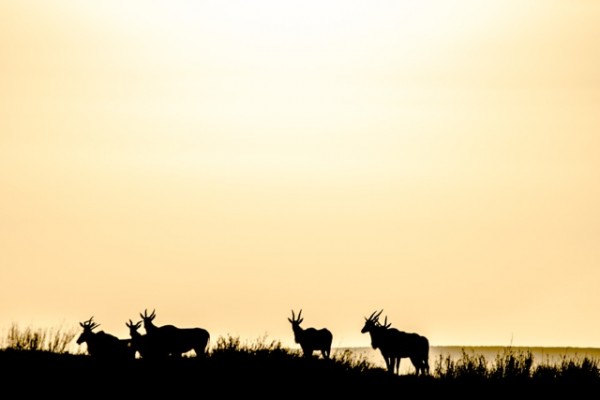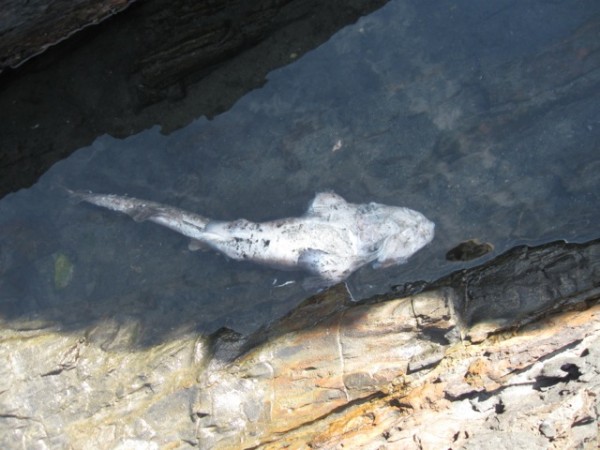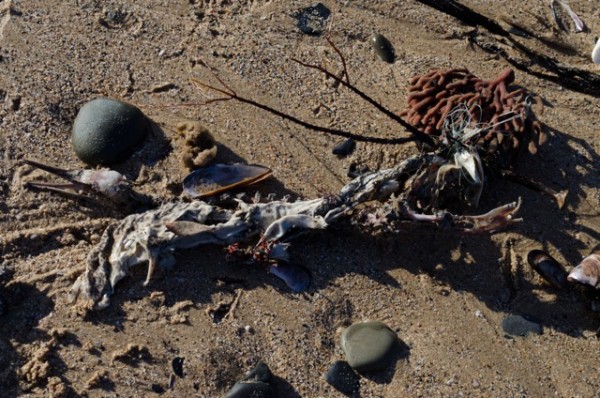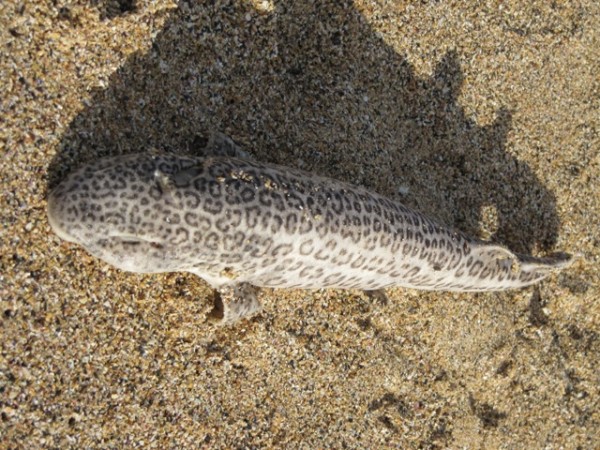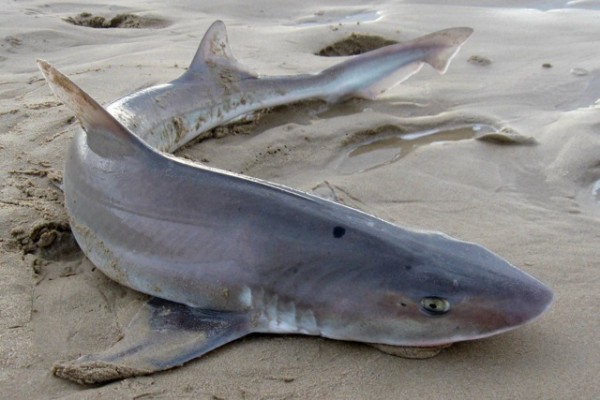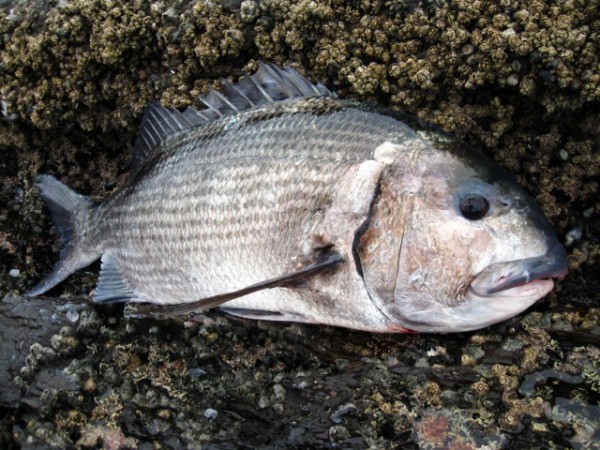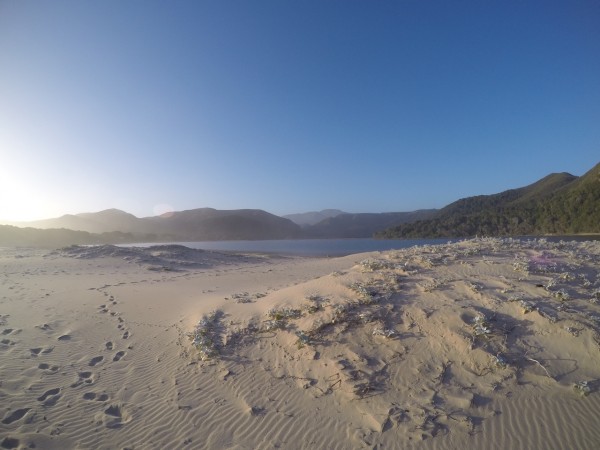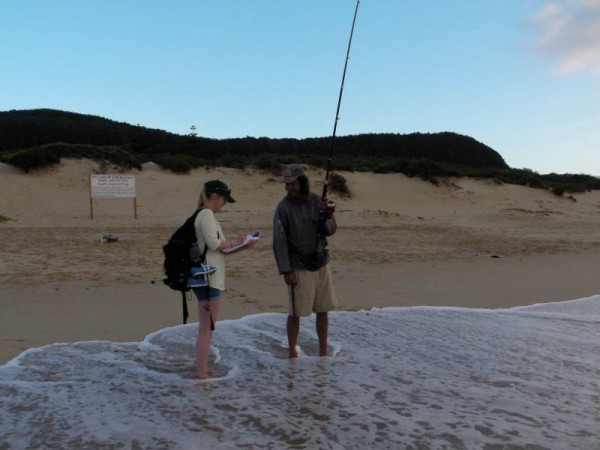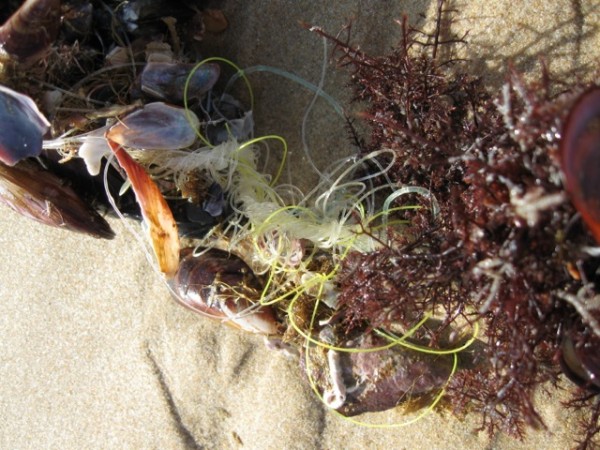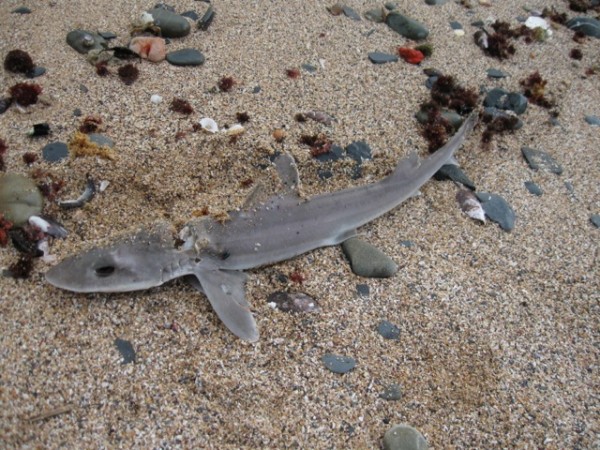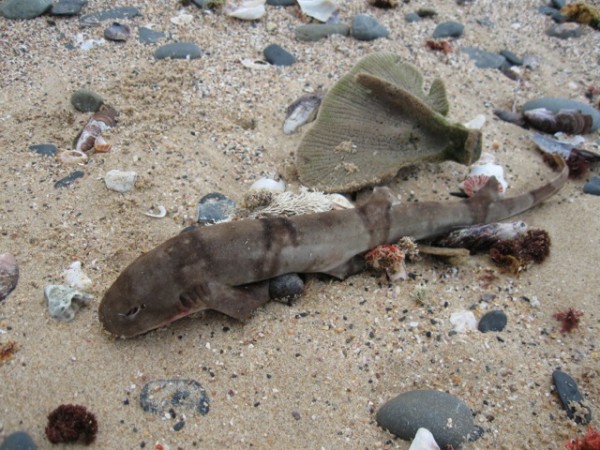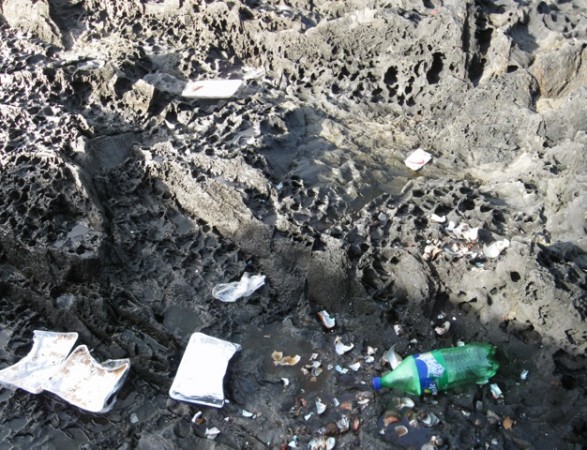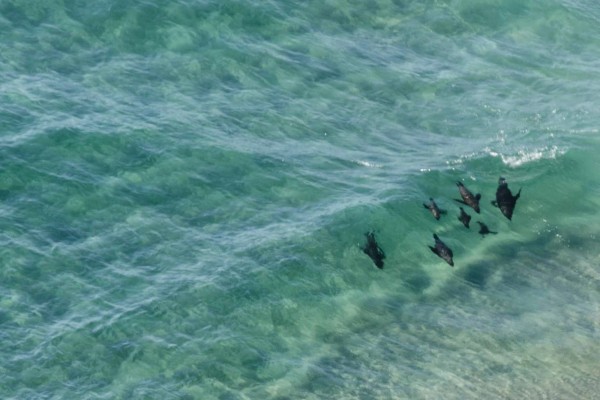Hello, my name is Lisa Schroeter and I’m a Master student of Ecology. In this blog I’m going to report about my research and everyday life in South Africa for the coming nine months. While on-site in a small, picturesque village named Nature’s Valley, I’m collecting data on the impact of shore-based line-fishery which is a popular recreational activity over here. One aim of the project is to assess the current state and temporal changes of fish populations with the help of fishermen interviews. Moreover it is the first
research project considering plastic debris in this area. During monthly sea gull colony visits, I will record animals, which are trapped or injured by fishing line. In the long run, the project should help to develop an awareness programme for local fishermen and the general public. It is a joint effort between the local Nature’s Valley Trust, the Institute of Ecology at the University of Bremen and the ZMT Fisheries Biology Working Group.
The project was granted a partial bursary by the Kellner & Stoll-Stiftung für Klima und Umwelt.
Südafrika 2015 | Foto: ZMT
23.10.15
Back in Germany
The fieldwork for my thesis was completed at the end of August. Before starting with the data analysis, I visited the Southern African Shark and Ray Symposium in Cape Town. It was an exciting conference, where I had the chance to meet lots of people with incredibly interesting research projects and most importantly, got the chance to network with them to make sure my ELMO (Elasmobranch Monitoring) project continues.
Now that I’ve had the time to look closer into my results and the study from a decade ago, the ignorance of an improved management plan and impacts of continuous overexploitation by anglers become evident: not only do fishermen have to fish much longer to land a catch than ten years ago, but in several species the fish have become significantly smaller. One species that seems to be affected is the White Steenbras. Almost half of all White Steenbras that were kept by anglers, were below the legal minimum size limit. We found very few medium sized individuals; most of them were either small or very large. Since this species belongs to the Sparids, which are slow-growing and have complex life-histories, serial or long-term overfishing can affect them severely.
Before I left South Africa, I spent one more day on the boat with Kyle Smith – the second try of getting BRUV’s underwater with an improved set-up. It was shyshark safe and octopus resistant but the rough waters along the Tsitsikamma coastline made the placement difficult enough and required some excellent skipper’s skills (which Kyle himself and the SAN-parks enforcement skipper certainly had). Going through the footage with Kyle, the differences between in- and outside the MPA became quite clear: The videos taken in Tsitsikamma had bigger schools of fish and a higher diversity of species than those outside. It is, however, not yet enough data, so that Kyle will continue this project for an undetermined period. It will be interesting to see first changes once the Park has been reopened to recreational fishing, which will happen in the near future.
The plastic data still needs to be evaluated but looking at the results of a partner-project in Nature’s Valley, we have seen that fishermen contribute large amounts of debris to the overall pollution.
Taking on this challenging project, which was a bit more intense than what is normally expected of a MSc thesis, was rewarded in many ways. I have come back with incredible data, my own on-going project and lots of possibilities for future work.
10.8.15
Plettenberg Bay
The BRUV story is a little postponed as our initial video set-ups were all taken apart by shysharks within the first ten minutes or switched off by a camera-shy octopus.
In the meantime my project is approaching the end. Only one month of data collection is left and I am looking at a couple of interesting findings besides the obvious, which are the overfishing and litter pollution caused by fishermen. Less expected was the amount of sinkers that gets lost on rocky fishing spots. Lead pollution is of rising concern amongst the scientific community and there are indications that recreational fishing contributes a substantial amount to that. According to some fishermen, several hundreds of lost lead sinkers can be found on a single reef. One angler claims to have retrieved more than 700 sinkers on rocky reef stretch shorter than 100 metres in Keurbooms.
What has also caught my attention is the number of dead Elasmobranchs I find in popular fishing zones. There are at least four common species of shysharks and guitarfish, which frequently compete with line-fish for bait. Thus they are seen as a nuisance by many fishermen, who carelessly throw them into dirty rock pools or onto the shore. Within six months I have recorded 17 sharks and rays that were hooked and left behind, assuming that the actual number is much higher, but not all areas are accessible and many specimen are washed away with changing tides.
In one incident I found a Leopard catshark (Poroderma pantherinum) and a Reed cormorant entangled together into a ball of monofilament fishing line, which still had a hook and sinker attached. As a consequence of these alarming findings I have started a citizen science project named ELMO – Elasmobranch Monitoring. It aims to collect all available data on egg cases as well as shark, ray and skate sightings to look at long-term population dynamics and distributions of Elasmobranchs. Therefore I composed an ID guide for common egg cases and established a website through which anyone can submit their findings or sightings.
In the beginning of next month I will visit the Southern African Shark and Ray Symposium in Cape Town where I can discuss the effects of fishing on Elasmobranch populations with other researchers. In the meantime Kyle and I will hopefully be able to try another BRUV run with an improved set-up.
8.7.15
Plettenberg Bay
Now that the South African winter season has kicked in and the July holidays are coming to an end, the coastline has become quiet. With only a few local anglers left, I often share the scenery with no one but myself. The silence however is deceptive. What is really happening at the moment is the famous sardine run – a mass migration of South African Pilchards away from the cold Cape waters towards the warmer environment in KwaZuluNatal and with them plenty different marine predatory species.
Here in Plett we are lucky enough to spot three different species of dolphins (Humpback, Bottlenose and Common Dolphins), three species of whales (Bryde’s, Southern Right and Humpback Whales) as well as various shark species. It seems that especially the Great White Shark is very prominent around the Bay. Up to eleven individuals were sighted on a single day, one was caught just off the central beach and two shark attacks (none of them fatal) happened here in the past few weeks. Unfortunately the public projects an incorrect combination of fear or belittlement on this charismatic predator.
As local researchers are well connected and quite busy at the moment, I got the chance to join a few day trips with some of them. Alejandra Vargas-Fonseca for instance is currently conducting a PhD project on Dolphin research and acoustic monitoring in the bay. We spent a day on the boat looking for pods of dolphins (finding the Indo-Pacific humpbacks - Sousa chinensis). Driving past the large seal colony on the Robberg Peninsula, we spotted not only thousands of Cape Fur Seals but also a nice sized Great White Shark.
The most special wildlife encounter however happened on one of my own fieldwork days in Keurbooms. As I guided volunteers to my favourite, crystal clear Rockpool on a cold and miserable day without fishermen, we spotted two Cape Clawless otters (Aonyx capensis). As I explained how special this encounter was, with my feet dangling in the pool and the volunteers watching from a safe distance, both otters came close up to me. In fact, they came so close, that their whiskers tickled on my toes. Otters are inquisitive but naturally illusive and I had never heard of a likewise encounter before.
I realized quickly that the volunteers and myself had to overcome the professional distance typically provided on my fieldwork excursions because what I had to do left no space for pudency. I told them to turn around for a moment, stripped off a warm layer of clothes and glided into the rockpool. It didn’t take long until the otters came up. For about 15 minutes I swam and dived with them, most likely a couple returning from their morning feeding. It’s hard to say who was more curious and excited: Them or me. Or maybe the volunteers waiting on the shore. Chatting to other local wildlife researchers about this unusual behaviour of these animals, we came to the conclusion that they must have been familiar with my looks and smells since I spend a significant amount of time passing through their territory. And who knows, maybe they finally wanted to put a face to the smell just as we like to put a face to a name.
Last week I joined Kyle Smith, the current SAN Parks marine Ecologist, to deploy BRUV’s (Baited Remote Underwater Videoing) in order to collect additional data for a comparison of fish populations inside and outside of the Tsitsikamma MPA. This trip is a story on itself and will be the topic of my next blogpost.
16.6.15
Plettenberg
The Plettenberg Bay area, extending all the way up to Tsitsikamma, is an incredibly precious and beautiful region. South Africa’s largest land-based Kelp Gull breeding colony is right here and marine wildlife is very abundant due to the proximity to two marine protected areas. But not all is perfect in paradise: Pollution is a world-wide issue that needs to be addressed.
Across all three of my study areas, I collect a monthly sample of beach litter. The debris items are categorized according to the ICC. Although the local management organisations SAN-Parks and Cape Nature do weekly beach clean-ups, we find a high amount of debris along the coast. Interestingly most of the litter can be directly linked to shoreline and recreational activities. Many debris items however are broken down to a point where they cannot be related to any particular source. The third strongest litter contributor is unfortunately the fishing community. At least 17% of the debris is clearly related to fishing such as fishing-line, bait cotton roles, bait packages etc. This does not even include snack wrappers and plastic bottles that are often left behind by fishermen.
98% of the fishermen I interviewed claim that they always take their litter home or to the bins. Only a few admit that they occasionally leave it behind. Some believe that it helps to create jobs because someone will come to pick it up. It sounds silly, but job creation plays a big role in South Africa’s communities.
Generally however, the coastline in this area is relatively clean compared to other parts of the world. Luckily there are many responsible fishermen who do not just take their own litter home but also pick up others’. There is a good chance that with a well-planned education programme and enforcement strategies, the littering can be minimized and effects on wildlife reduced.
12.5.15
Plettenberg
It’s been a while since the last blogpost. The research has been quite hectic since the MPA conference in Langebaan. By now the busy tourist season has ended and mostly local fishermen are left. This has given me time to resume some first impressions.
A large part of the fishermen I encounter call themselves “subsistence” fishermen, which means that they are dependent on their catch as they don’t have any other income. Although fishing regulations in terms of species-specific minimum sizes, bag limits and closed seasons are in place, their enforcement is almost negligible. Subsistence fishermen, who are suffering from the significant decrease in fish numbers and sizes, claim to not being able to “afford” sticking to the rules. Often I encounter a lack of understanding and ignorance amongst subsistence as well as recreational fishermen. Some over-exploited and slow-growing species, e.g. the White Steenbras (Lithognathus lithognathus, classified as “endangered” according to the IUCN redlist), have a high minimum size limit at 600 mm. I do however observe regularly that way undersized individuals (smaller than 200 mm) are kept for the use as live bait or to prepare fish cake or pickled fish. Whereas fishermen are struggling to master their daily lives, the fish populations are being increasingly exploited. This conflict is extremely frustrating and difficult to solve.
A crucial step to a sustainable management of Plettenberg’s fish populations is education. Many fishermen have certain beliefs in the reason for the decline of fish. For example, many of them are convinced that the seals, which have recently recolonized the Robberg Peninsula, are the major competitors for fish. Yet a study showed that the Robberg seals mainly feed on bait fish such as sardines and anchovies, whereas line-fish only comprise about 1% of their diet. Another ever-lasting issue are Marine Protected Areas – specifically the Tsitsikamma National Park. Many fishermen call for a re-opening of the MPA for fishing because they have heard (from illegally fishing companions) that the fish inside the park are plentiful and big. They however do not understand that the reason for this difference in abundance and size is a consequence of the exclusion of fishing pressure in this area, which gives the fish populations the opportunity to breed relatively undisturbed. A thorough education programme can try to explain the basic principles of spatial protection to the local population and thus raise the level of understanding and acceptance of such protective measures.
In the next blogpost I will give an insight on the litter composition along the coast of Plettenberg Bay and the role that fishermen play in it.
23.2.15
West Coast National Park
Last week I had the chance to accompany my supervisor Mark to the National Forum for Marine Protected Areas in South Africa. The DEA (Department for Environmental Affairs) and WWF South Africa had chosen to host the meetings in the West Coast National Park. It indeed was a great place to experience the variety of values of Marine Protected Areas (MPAs). They serve as important nursery, breeding and feeding grounds for many threatened and exploited fish species.
MPAs however are not just about fish, they offer protection for entire ecosystems, which include birds, invertebrates, plants and many other organisms. Thus it was very pleasant to hear that South Africa is planning to declare more MPAs, including off-shore habitats, as part of the famous operation Phakisa (Sesotho: “Hurry-up”). We had the chance to talk to many people who are responsible for the management of those MPAs and learned a lot about the challenges that come with it.
In a country with such a beautiful cultural diversity as South Africa, it is especially important to respect and include the human dimensions of a protected coastline. Several fishermen from different communities all over the country had the chance to present their views and experiences with protected areas. They also learned more about the complex idea behind it and can take that knowledge home to their communities.
Surprisingly there were very few scientists invited to the Forum although they should be an integer part of the management. One of the most important things that I learned at the Forum was, how essential communication is for the success of such undertakings. Not only should the different responsibilities, study results and interests of the involved stakeholders be communicated clearly, but a vivid exchange of ideas and experiences in a national and international context can take the achievements of MPAs to the next level.
Whenever Mark and I weren’t stuck on uncomfy chairs during midday heat listening to presentations, we tried to make most of our stay and explored the West Coast National Park. It is especially well known amongst birders for its fantastic bird hides. We usually got up a couple of hours before the programme started and saw some pretty cool and rare species. Besides loads of waders, we photographed beautiful flamingos in the sunset, many different raptors (also the endemic Black Harrier) and other cool species such as the White backed Mousebird and the Black Koorhaan.
A huge highlight was a trip to a Cape Gannet and Cormorant colony on the Malgas Island near Langebaan, which is normally closed for the public. The National Park Manager organised several Marine Enforcement boats to give all participants a chance to see this magnificent place and we had a pretty hectic and awesome ride. During our drives through the mainland parts of the park we also encountered herds of Elands, Kudus, a young puffadder, ostriches, tortoises and many others.
All in all, the trip to the MPA Forum was a great chance to meet people who are involved in similar projects as my fishermen surveys. Furthermore we managed to represent the scientific interests in MPAs during the conference and made sure other attendees learned about the work we are doing locally. The West Coast NP is a great example of how species rich and diverse South Africa’s coastline is and that we carry a huge responsibility in conserving these areas in order to maintain their function for our own and future generations.
Lisa Schroeter, WG Fisheries Biology (ZMT) and Institute of Ecology (University of Bremen)
21.1.15
Nature’s Valley
After a relatively comfortable journey along the 18th degree of longitude, a scenic inland flight and a short ride along the Garden Route, I have finally had the time to re-explore Nature’s Valley. I could hardly wait to drop my suitcase before heading down to the sea. My new home is located inside a forest and on the way to the beach one might encounter a whole lot of species, such as boomslangs (Dispholidus typus), bushbucks (Tragelaphus sylvaticus) and guinea fowls (Numida maleagris). Besides them, there are also Vervet monkeys and Baboon families resident in the forest and they don’t mind to pay a visit to private households either.
This does not only mean that everything in Nature’s Valley needs to be made monkey-safe but also that we have to keep the windows closed at all times. Before leaving for the beach, I was instructed that I must under no circumstances ever forget to lock the door – no matter whether I’m inside or outside the house. Baboons are clever and an unlocked door is an invitation for a delicious snack.
Although most things are still the same as five years ago, this time it is an unlike experience. With an actual education in natural science, several things appear in a different light to me now. Below the endless blue water surface, complex processes take place in a closely cross-linked ecosystem, which we can only relate or understand in fractional bits. Thus it is important to comprehend the possible impacts of our actions – such as the removal of targeted fish species, which themselves play a finely tuned role in this system.
In this study, I am spending nine days per month interviewing fishermen along three stunningly beautiful stretches of beach between the Tsitsikamma National Park and the Robberg Reserve. I’m feeling very privileged working and living in such an area. The fieldwork days start at 6 in the morning. On the first survey day, we early birds were rewarded with two pods of Bottlenose dolphins jumping through the bay, accompanied by giant flocks of Cape Gannets, Cormorants and Kelp Gulls. The first zone ends at a beautiful spot called “Salt River’s Mouth” which is only accessible during low tide (see picture). With the right timing I managed to complete three circuits of this zone within 12 hours – including a short lunch break that I used to jump into the temptingly clear waves.
I’m telling you, 12 hours beach walking in South African summer really got to me as I just came from German winter temperatures. More precisely it got to my feet where sunscreen 50+ just didn’t want to stay on and was rubbed/washed off by sand and saltwater. The result was lobster red feet that were swollen to a scary size. Nevertheless I managed to interview 5 fishermen, which were all keen in participating (and of course, did not hold back with jokes about my sunburn). After a successful day at the beach, I packed my stuff to prepare for another fieldwork day in the zone in and around Plettenberg Bay – my new secondary home. I can’t wait to tell you about the amazing experience I had in the Robberg Marine Protected Area, which I will come to in the next blogpost.
Lisa Schroeter, WG Fisheries Biology (ZMT) and Institute of Ecology (University of Bremen)





